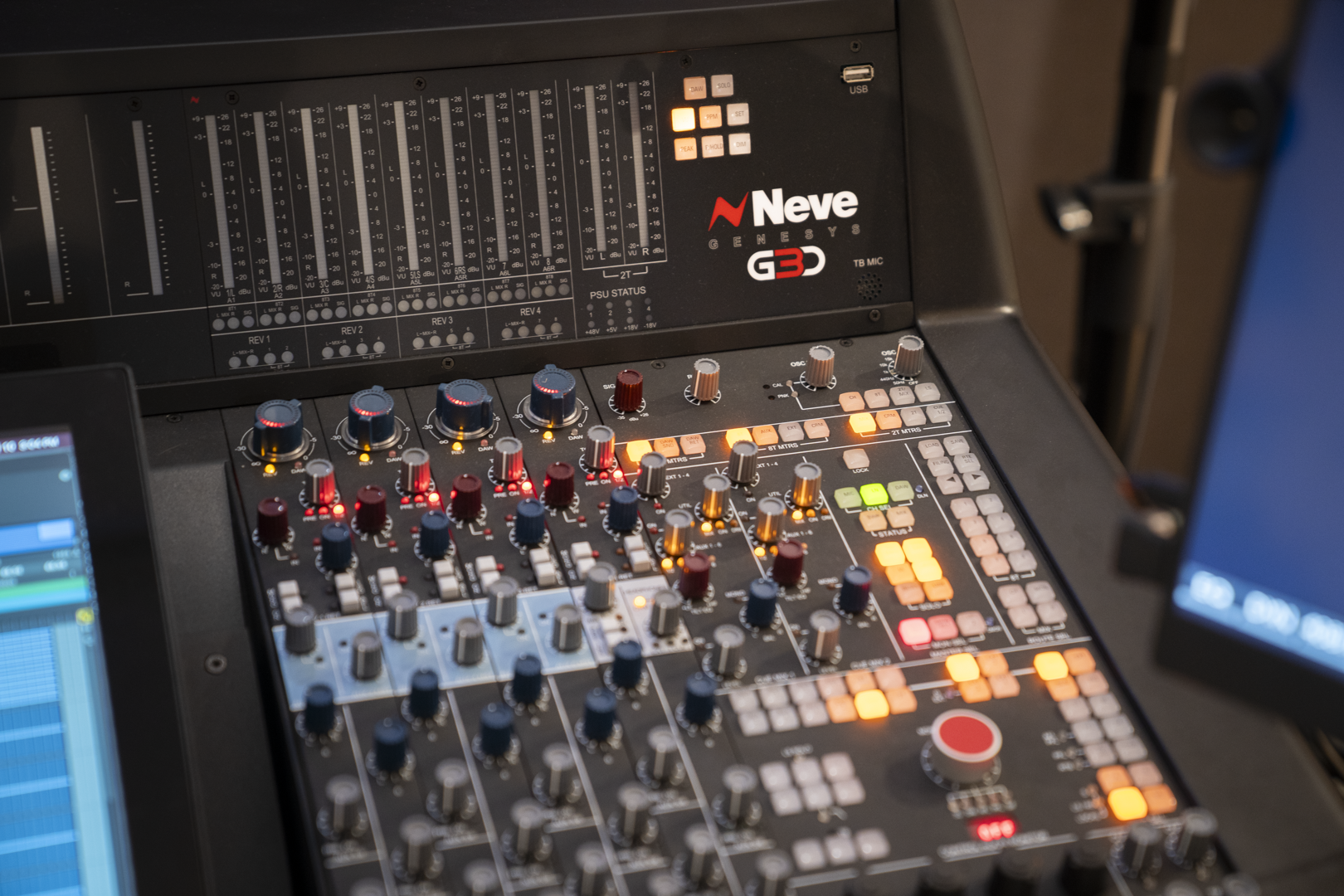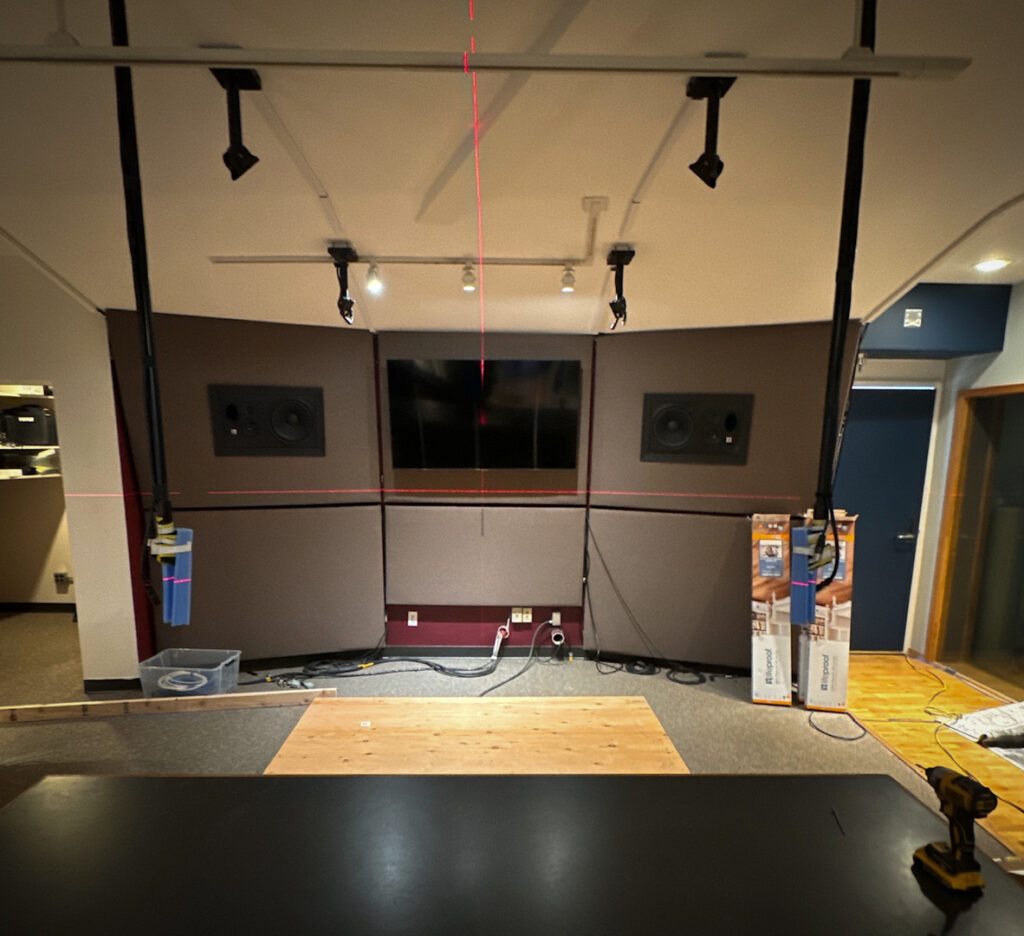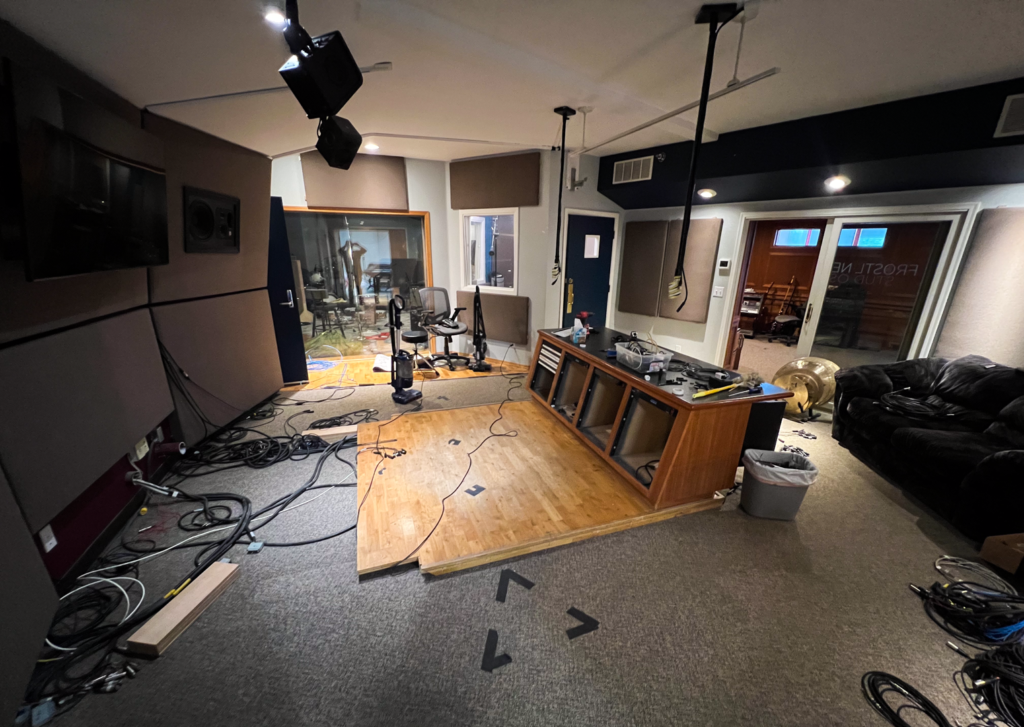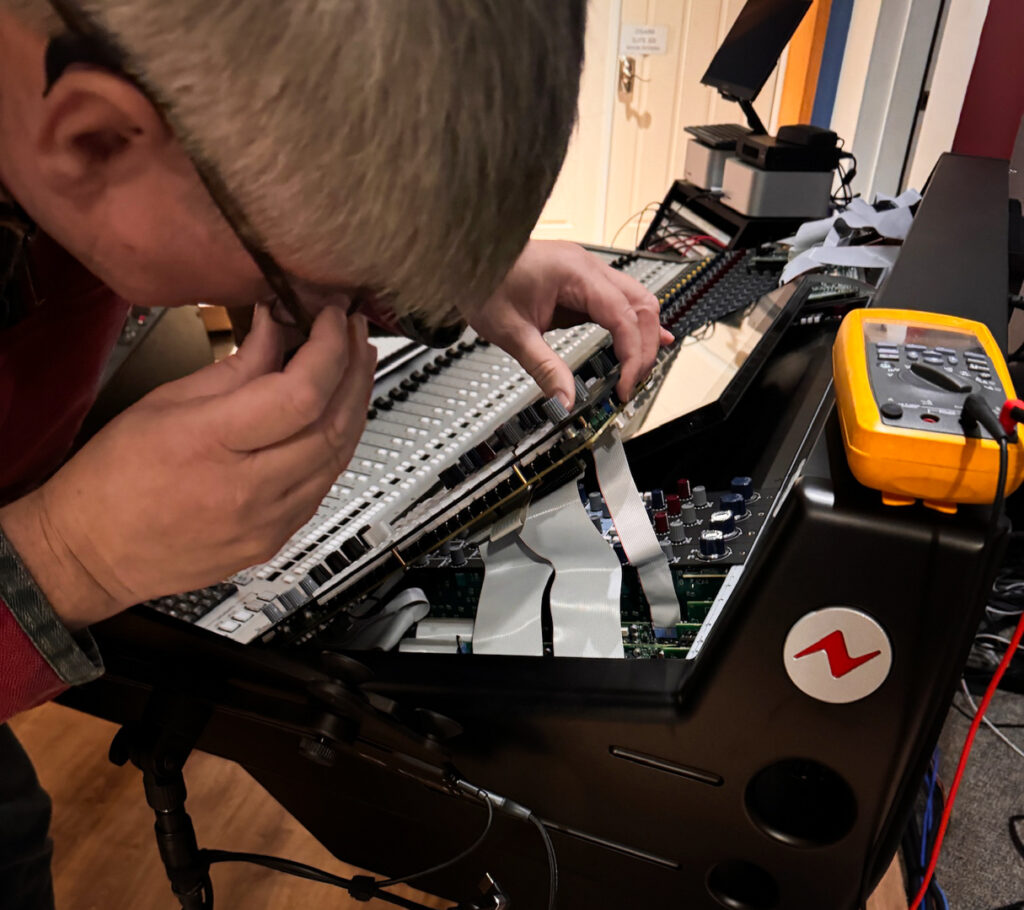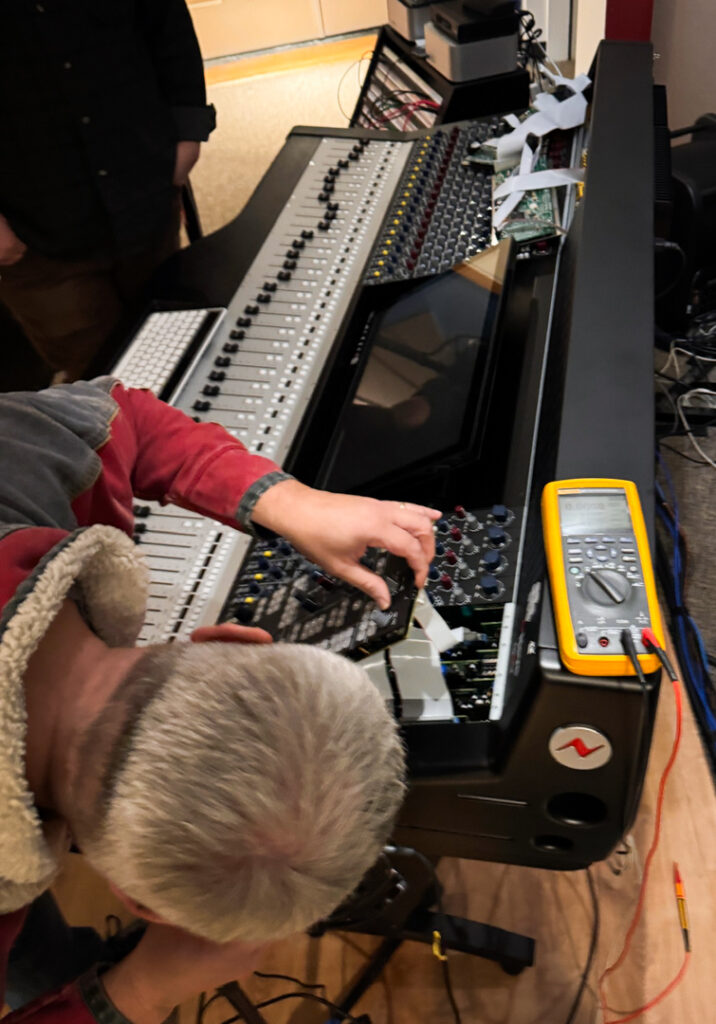Over the past year, our audio control room got a complete makeover with the installation of a brand new Neve Genesys G3D console – the world’s first mixing console with object-based hardware and software, which allows analog signal to be mixed directly from the console’s surface in three-dimensional Dolby Atmos surround sound.
In the course of installing the Neve Genesys G3D, we discovered that not only is this model the world’s first with these capabilities, but that the specific console we have in our control room is the very first of its kind to be shipped from the Neve factory.
In our latest episode of Hold For Sound, Mantha talks with Senior Audio Engineer, Derek Haukaas, and Frostline Studios’ Founder, Richard Cooper, all about the new Neve console: what it is, why we chose it, and what the install process was like.
Meet Rich & Derek
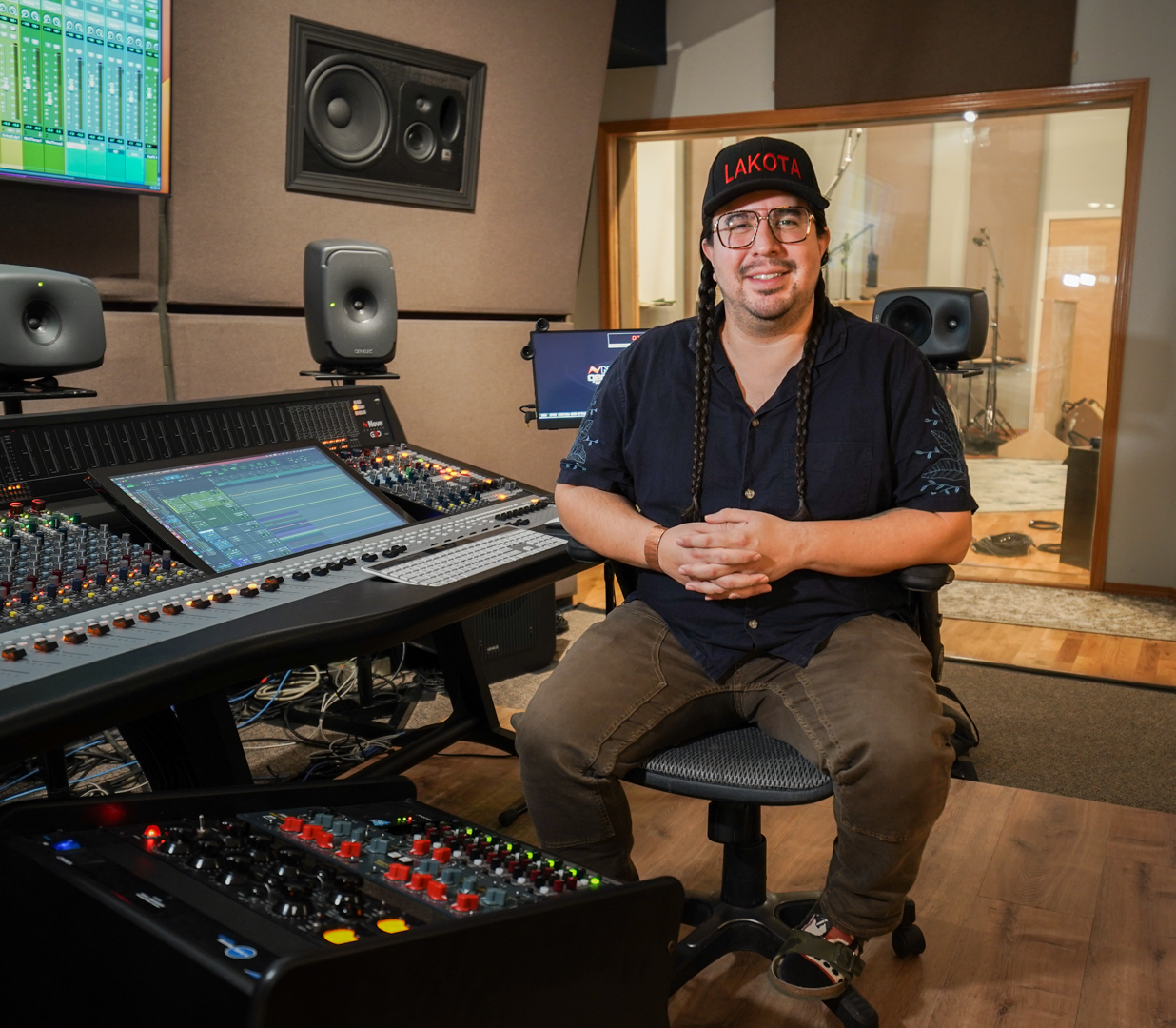
Derek Haukaas was our very first guest on the podcast! He’s a sorcerer of sound down in Studio A, where all the audio magic happens. He’s a two time Emmy® award winning re-recording mixer and his work bringing Indigenous musicians’ work to life has been recoginized through a Rasmuson Project Award. In his time off (and often while on the clock, too) Derek can be found jamming out behind a drum kit.

Richard Cooper is Frostline Studios’ founder. He began his career early at 14 years old as a touring musician. His dream was always to score films, and in pursuit of that goal in the early 2000s, he discovered video production. After founding his own film company, Frostline Productions, he began travelling Alaska to tell its people’s stories through film. His commitment to quality storytelling through both music and film has heard him 5 Emmy® Awards, 3 Telly Awards, and 2 Aurora Awards. When he gets some free time, you’ll find him on the golf course, composing music, or spending time with his family.
Building out Frostline Studios’ Facility
The upgrades to our recording studio mark an important milestone in Frostline’s trajectory, and stands as a testament to the vision Rich has had since starting the company. While his career started out in music, Rich originally founded Frostline as a film company under the name “Frostline Productions.” Things came full circle, however, when he moved into the facility we currently call home.
The previous occupant, Charlie Hewitt, was a friend of Rich’s. He had built the space as Mirror Studios: a world-class recording studio with multiple isolated vocal booths, a space for tracking live bands, and a control room – each wall specifically angled with acoustics in mind. But in 2018, with kids all grown up, Charlie was retiring and relocating to Idaho. Rather than letting this incredible space get demo’ed back to offices, he gave Rich a call to see if he wanted to take it over.
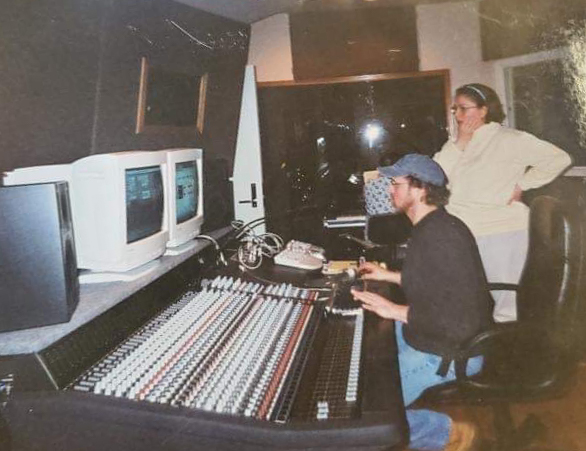
The control room back in the Mirror Studios days. Photo courtesy of Samuel Sease.
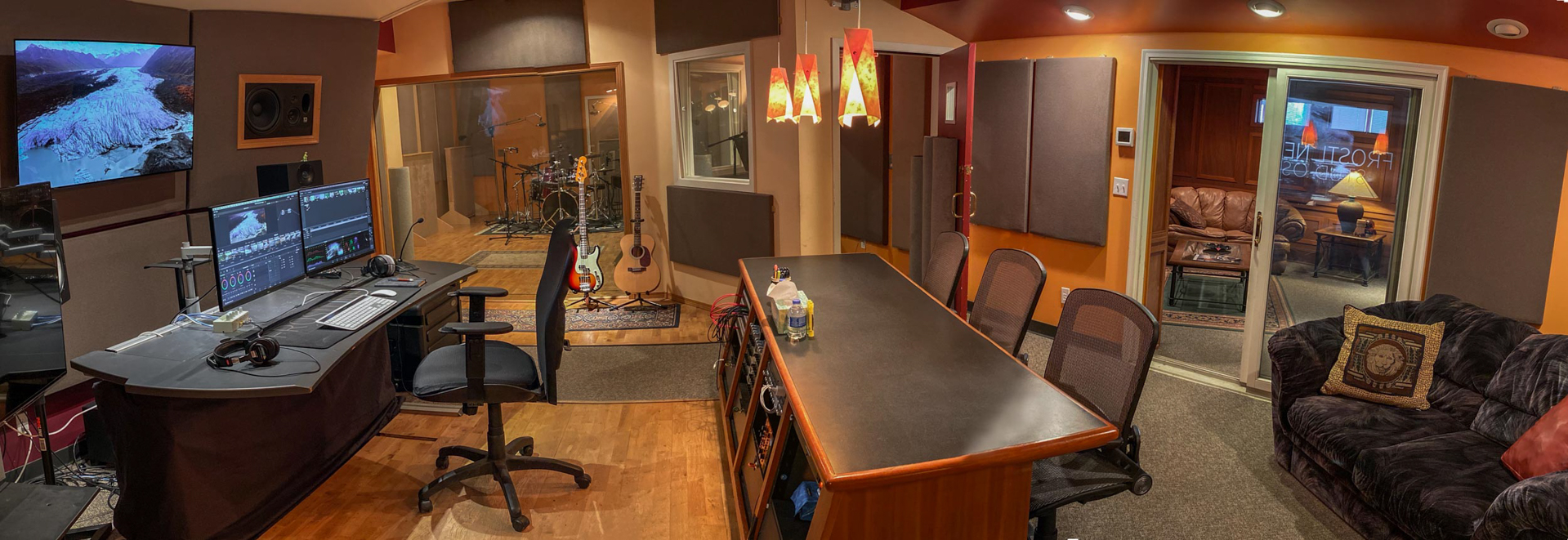
The Frostline Studios control room in 2020.
Rich gladly took him up on it. With a recording studio now at his disposal, he rebranded as Frostline Studios – a video and audio company – and began to build his own music and film production space on the foundation Charlie had left behind.
Through patch bays and Pro Tools plugins, the control room gradually expanded to meet the diverse needs of Frostline’s clients – including tracking live drums for local musicans, recording dialogue for Fox Animation’s The Great North, and mixing audio for both film and music.
World-class capabilities for anyone with a dream
Beyond just being a recording studio or post-production house, Rich wanted to be able to offer Alaskans and visiting creatives cutting-edge technology for their audiovisiual endeavors. “It’s important that Frostline offers world-class capabilities to everybody that has a dream,” Rich says in the podcast. To that end, he was one of the first people in Alaska to begin digital color grading back in the “Frostline Productions” days, and when he discovered Dolby Atmos, he knew he needed to incorporate the capability into the company’s repertoire.
This new console – the Neve Genesys G3D – finally made that dream possible.
What is Dolby Atmos?
Dolby Atmos is a surround sound technology for speakers and mixing in which audio files are treated as “objects.” These objects can be programmed to move around in three-dimensional space in the mixing software, so when you listen back, it gives the impression that the sound object is floating from speaker to speaker.
Audio objects float in 3D space in the Neve’s Dolby Atmos interface.
A system that can play audio in Dolby Atmos includes speakers in the ceiling, allowing these sound objects to move not just from left to right (as they do in stereo systems), but also up and down. This 3D element is part of what makes the surround sound technology unique, and is what gives our new console – the Neve Genesys G3D, which has Dolby Atmos mixing specifically built into it – its name.
But the addition of a vertical dimension isn’t the only thing that separates Dolby Atmos from other immersive audio systems. “Most surround sound formats are 5.1, 7.1, etc,” Derek explains. “Those numbers stand for a number of channels, so 5.1 means you’ve got five speakers around you (the ‘point one’ is your LFE / Low Frequency Effects channel) and 7.1 means seven speakers around you. What is unique about Dolby Atmos is that it’s not based on a specific channel count, it’s based on 3D space. So when you do an Atmos mix, it then folds down into whatever playback system you are listening back to it in.”
Development of Dolby Atmos
El Capitan Theatre in Los Angeles. Note the speakers hanging from the ceiling!
Dolby Atmos was initially designed to expand the audio landscape of film. It made its debut at the El Capitan Theatre in Los Angeles for the premiere of Brave in 2012 and has quickly become the gold-standard for film and television, with most streaming platforms preferring or even requiring Dolby Atmos mixes of the content they provide. More recently, it’s becoming increasingly popular for music as well, in part thanks to improvements in consumer playback systems – whether that’s home speaker systems, headphones, or even car audio.
Like the transition from mono to stereo in the 1970s, this new audio technology is opening up a “new dimension” for mixing and listening to music. “You’re not having to cram all your information into two stereo channels,” Derek says. “You can hear stuff that you couldn’t before because it’s got space to actually breathe.”
There truly is more “space” in an Atmos mix than a stereo one. Dolby Atmos is not restricted to squashing all the information into two channels of audio. There is a whole 3D space around you that you can explore, and it results in greater dynamic range and the opportunity for deeper emotional engagement through sound.
That level of depth and clarity is really noticable in some of the Atmos remixes of songs like Elton John’s Rocket Man, Queen’s Bohemian Rhapsody, or Fleetwood Mac’s The Chain (available on platforms like Tidal and Apple Music). Even though you’ve heard the song a million times already, the Atmos remix brings out things you never knew were there. “You’re hearing things in the song that you’ve never heard before because there’s so much space now in the sound field that all of this intricate stuff can come out and have a place in the mix,” Rich says.
Like many other engineers, Derek is excited about what this means for the art of mixing, in that it opens up new ways to convey emotion in music. When you listen to an Atmos mix, you’re not just listening to a song, he says. “You’re in the world that the artist created with that song.”
Bringing Atmos to Alaska

Sound stage at the Skywalker Ranch.
Rich got his first hands-on experience with Dolby Atmos when working on the feature documentary Boneyard Alaska with filmmaker Paul Lawrence in 2018. They took the film to Skywalker Ranch to work with re-recording mixer Christopher Barnett (whose credits include films like Icarus and The Green Knight). That experience was all it took. Dolby Atmos’ possibilities captured Rich’s imagination, and he set his sights on bringing the technology to Alaska.
Molding Frostline’s control room into a functioning Dolby Atmos certified system, however, was easier said than done. The existing system already took a long time to switch between types of sessions due to they way it had been built. Having an ADR session with directors patching in from London in the morning and a tracking session with a full band in the afternoon meant the engineer had to scramble to get everything set up, even if there were hours of buffer time between the two sessions. Adding yet another capability to the mix (while still retaining the ability to efficiently serve the diverse needs of our clients) proved just out of reach.
Still, Rich was determined to equip Frostline Studios for Dolby Atmos. “We started to cobble together a system for it,” he says. “Then I saw this ad about the Neve Genesys G3D, which takes that analog quality of Neve and puts it in a digitally-controlled, completely automatable, Dolby Atmos capable console.”

The new Neve Genesys G3D console at Frostline Studios.
Three words there are key: analog, automatable, and Atmos. Not only does this console have Dolby Atmos technology built in, it has digitally-automated recall hooked up to the console’s physical hardware, meaning the hours upon hours of set-up time between sessions would be a thing of the past.
Derek and Rich had looked at getting a new console before, but none of them were quite right for all the different things they needed it to be able to do. “Because we do so much work in both music and film and TV post-production,” Derek explains, “whatever we get can’t just scratch one of those itches. It’s got to be transferrable to both sides of the company. The Genesys’ recallability has been around for a bit. But this new G3D upgrade and the master section of the console – which is the Dolby Atmos integrated portion of it – that is what is completely new.”
Analog vs. Digital
So what do we mean by recallability and analog quality? In short, it comes down to how you’re manipulating the signal: in the computer, or on the hardware.
For years, engineers had to choose one method or the other, and each came with its own pros and cons. The automated recall technology featured in many of Neve’s consoles and outboards, however, seamlessly integrates both analog and digital signal processing.

AUDIO SIGNAL FLOW. The signal converts from analog to digital after it passes through the hardware. When you listen back to something on a set of speakers, it goes through the same process, just in reverse!
Analog: superior sound quality, a lot of work
“My approach to whatever we’re working on is to try and get things right at the source,” Derek explains. The signal we work with originates as sound waves with the voice actor, vocalist, or musician’s instrument, then is picked up by the mic where it’s transformed into electrical signals and passed along into the hardware, converted into digital data, and passed into the computer. Derek tries to get everything sounding as close to how he wants it before it becomes digital data by using the right rooms, mics, and hardware, rather than manipulating the audio in the software.
Every audio engineer will have his or her own opinion, but Derek simply prefers how analog signal sounds (that is, the way it sounds before it’s converted into digital data). “There’s not a harshness, especially with EQ,” he says. “Digital EQs, when you put them side by side with their analog predecessors, can tend to have a brittle sound to them.”
But recording, mixing, and mastering all in analog is tedious work. For example, Derek may decide he wants to change something on a mix a few weeks after the last time he opened up that session. Now he’s got to look back at the notes that he made and manually re-dial in all the settings from weeks ago on each channel in his entire signal flow, hoping his notes are accurate and that it’ll sound the same. “It makes that workflow difficult to be fast in when it comes to having to juggle multiple projects at a time,” he says. With everything we do at Frostline, it just wasn’t feasible to us — until now.
Digital: streamlined workflow, but just not the same
Digital signal processing, on the other hand, solves that workflow issue via recall, automations, and presets that significantly decrease the amount of time needed to set up any session. But the sound just isn’t the same.
“It’s difficult to fully replicate what happens when you’re actually sending electricity through copper and iron and all of those components that are inside each channel strip. What happens to the signal and sound through that process, whether it’s recording or sending it back through the console for a mix, is hard to replicate in a fully in-the-box digital setting,” Derek explains.
The master section of the console lights up during a mixing session.
The physical hardware of the console can be manipulated through digital commands. Faders appear to “move by themselves” while we run tests during installation of the Neve Genesys G3D.
Putting it Together
The Neve Genesys G3D console uses digitally controlled hardware to combine the best of both worlds. With our old system, we mixed audio digitally in Pro Tools software. But this new system allows us to perform the mix on the actual hardware using Pro Tools to control it via the Neve channel strip plugins – without any of the tedious setup usually associated with analog mixing. “It goes through the console when it goes in and it comes through the console when it goes out,” Rich says.
“Each channel strip on the console is controlled digitally via a set of encoders,” Derek explains. The encoders link the physical hardware of each channel strip to the console’s software, as well as into your channels in Pro Tools. This integration allows you to automate things like EQ rides on the physical hardware from directly within Pro Tools. And it’s not just snake oil; you can see and hear the hardware responding to the manipulations in the software, he says. “You can be there within Pro Tools, specifically on the 88R EQ modules, you can be adjusting the parameters on each EQ knob and you can hear the detented pots on the channel strip clicking inside the console.”
All this not only streamlines work done within the sessions themselves, but also means Derek can switch between mixing, mastering, and different kinds of tracking sessions at (essentially) the push of a button.
Since the installation of the console was completed, our workflows have sped up significantly. It now takes much less time to get the results that we and our clients want. “Which translates to lower budgets and better and better service to the client,” Rich adds. As we continue to deepen our knowledge of the console’s comprehensive capabilities, our efficiency will only increase.
A Whole New System
Given all this, it was a no-brainer to go ahead and make the big investment in the console. But rather than just plugging the new machine into our existing systems (which wouldn’t have really been possible anyway), we took the opportunity to re-design the entire control room from the ground up.
The goal was simplicity. Before, the control room’s system of hardware – while it had served as well – was a complex franken-network that had been cobbled together over many years using a bunch of gear from different manufacturers. While the combination of outboards, plugins, and various other equipment made a comprehensive system, the complexity of it introduced latency issues and encumbered our workflows. It was time to start anew.
“We literally took everything out of the control room,” Rich says. “There was nothing left. Not a cable, not a piece of hardware, no computers, nothing. It was empty.” After a week spent taking the control room apart, we spent another week putting it back together with all new gear, including a whole new monitor system and audio converters.
Automated tuning of our Genelec SAM™ studio monitors during the installation of the Dolby Atmos setup.
Genelec Studio Monitors
Beyond the new console, the control room now has 11 Genelec Smart Active Monitoring (SAM™) studio monitors and two Genelec SAM™ subwoofers. They’re more than just speakers; each one has a mini-computer inside that controls the tuning and time alignment process for increased efficiency and accuracy.
Having your speakers tuned and time-aligned with each other is extremely important even for a stereo system, Derek explains. “But when you get that many speakers all around you, it’s exponentially more important.” Before the remodel, if a speaker got bumped or something didn’t sound right, Derek had to take at least a day to manually tune the room. Now, even with a 13 speaker Dolby Atmos system, it takes just 20 minutes.
Not only do the smart speakers cut tuning down to a fraction of the time, their audio quality is top-notch. That means Derek can turn the volume down to reduce ear-fatigue during long mixing sessions and not worry about losing clarity in his space. In addition, Derek’s noticed that tracks he’s mixed on the Genelec speakers translate really well to other systems, meaning he can trust that something that sounds good in our studio will also sound good on a pair of headphones at home.
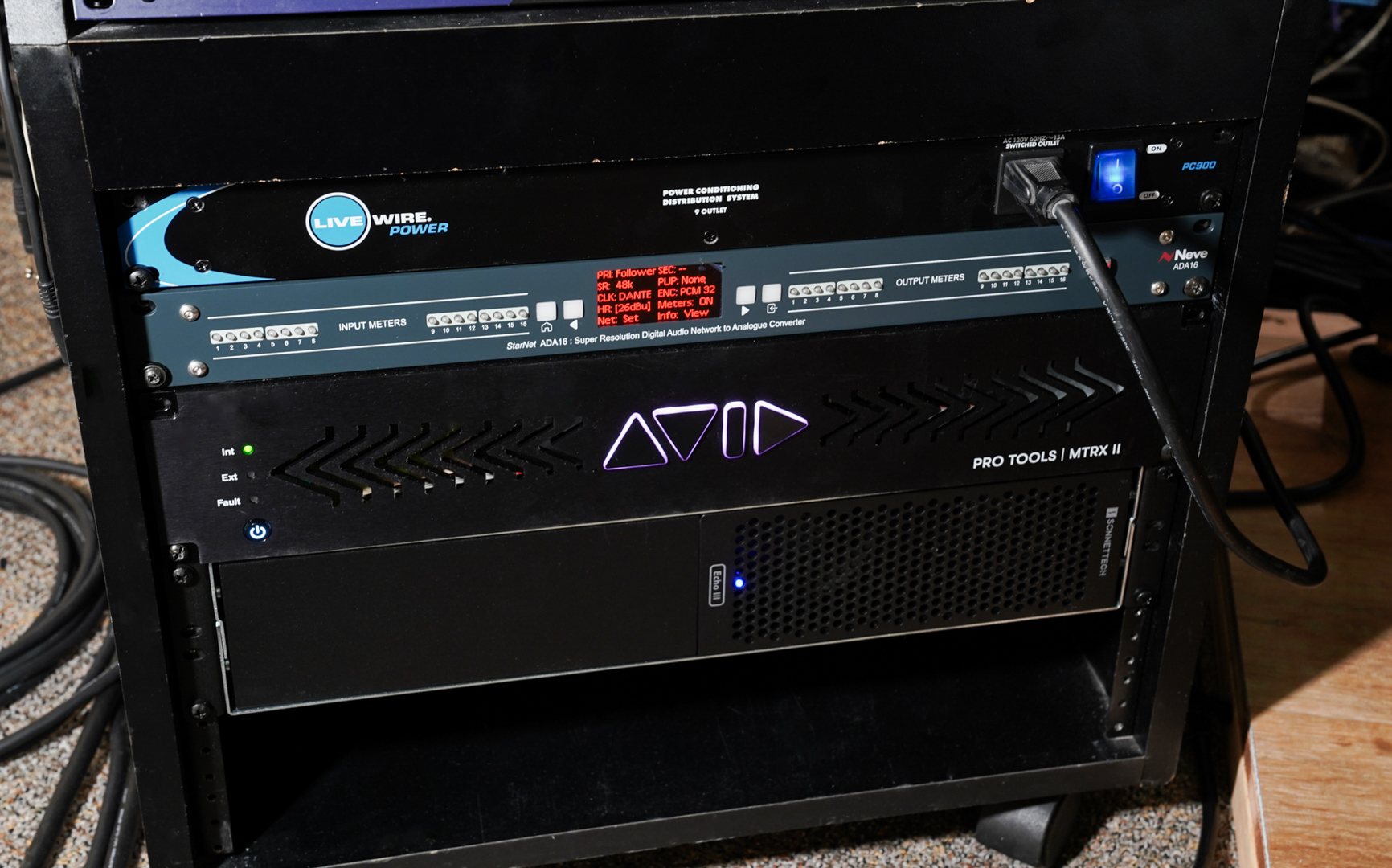
The Avid MTRX II manages the many signals running through the control room at any given moment with zero latency.
Zero Latency Network: The Avid MTRX II & Dante Interface
In order to manage all the inputs and outputs with versatility and efficiency, we upgraded our converter to an Avid MTRX II and Dante network to hold the studio’s new system together.
Again, the goal was simplicity. We needed one piece of gear that could handle everything from inputs for live band tracking to outputs for headphones, routing for Dolby Atmos tracking and mixing, additional room correction, and anything else we might ask of it. The MTRX II, along with the Dante interface and all the new cables, is able to handle it all – and it does so with zero latency.
Installing the Neve Genesys G3D: What We Learned
Trust the Process
In the middle of the installation, the control room was a mess of cables and boxes, like someone had made enough spaghetti to feed a giant, then dumped it all over Derek’s desk. At the height of the mess, it was hard not to worry if we would ever get it put back together again. “But it’s like that in business or in life,” Rich reflects. “You commit to a decision, and the just go. Deal with everything as it comes.”
To start, the process took a lot longer than we expected. We thought we’d be able to shut the studio down for a few weeks and have it back up and running by July 2024, but it wasn’t up and fully functioning until nearly the end of the year.
“The reality is that this console is handmade,” Rich explains. “They build them one at a time, to order.” After it was built (which took about three months), it was an additional few months for it to be shipped from the UK to Alaska, given its size (about the length of a large loveseat) and the fact that it had to come through customs.
“When we signed up to do this, I had no idea how much time an deffort it was going to actually take to make it happen. But that’s with everything, right?” Rich says. “I would do it again in a heartbeat.”
We completely gutted the control room of all equipment before bringing in the new console. Then, shortly after installation, a little surgery was needed to fix a small power-supply issue on the motherboard. During this process, we learned our console was actually the FIRST of its kind ever shipped out from the factory!
Work with Experts
After it arrived, we still had about two weeks of hard work ahead of us, tearing out the old system and working with Vintage King’s technician Frank Verschuuren to install the new one. With a system as robust as this, having an expert on site when getting up and running was crucial. Frank’s presence meant we could complete the process relatively quickly, with confidence that it was being done right, and immediately respond if there were any issues.
“And there will always be an issue – and there was an issue!” Rich says. A few days after Frank left, the console was having some trouble on start up. The team at Vintage King and Neve responded immediately, helping us to troubleshoot remotely. After a short period without any luck, the engineers at Neve said, “Okay, we’re going to send someone over. He’ll be there on Monday from the UK to fix this.”
First in the World
Two days later, the Neve engineer was in the studio, running more tests. In the end, the issue – while hard to diagnose and pinpoint – was very simple: a power supply malfunction on the motherboard. In the process of fixing the issue, the engineer let slip that this was the first Neve Genesys G3D console ever shipped from their factory.
“When we made the order, we were told we were probably number two or three in the United States to get this console,” Rich recalls. “I had no idea we were quite on that bleeding edge of technology,” he laughs.

Derek working on a mix at the console.
The Right Tool for the Job
It’s been so much fun learning to use the new system and test what it’s capable of. So far, we’ve recorded Indigenous drums and vocals using ambisonics microphones with James Dommek Jr. for his true crime show Blood and Myth, and tracked drums and vocals with Ya Tseen and Portugal. The Man on multiple songs for Ya Tseen’s upcoming album, including Taste on My Lips. We’ve mixed immersive audio experiences in Dolby Atmos with Paul Lawrence, tracked a 12 piece jazz band with Taylor Dallas Vidic, run remote ADR sessions for The Great North, and more. All this, and we’ve only just scratched the surface of what it can do.
The first time Derek printed a mix from the new console, he could feel the good things coming. “It was just a rough mix that I wanted to test on my headphones and in the car. I was driving home and listening to it and I was like, ‘Woah, okay. This is it.’ It’s that feeling of when you’ve been chasing something for so long. Now I have the tool I’ve been looking for to accomplish this.” He smiles. “It’s great.”
Want a Demo?
It’s hard to explain Dolby Atmos and the capabilities of this new console. “It really is something you have to hear,” Rich says. “It’s the only Dolby Atmos facility in the state, and it can be a game changer for projects.” If you’d like to come and hear it for yourself, give us a call!
Further Reading & Listening
The intro and outro song for this episode of Hold for Sound is “Stop and Get Some Gas” from the Casey Smith Project. Recorded, mixed, and mastered at Frostline Studios.
- Some of the lastest tracks out of Frostline Studios:
- Ya Tseen – Taste On My Lips (feat. Portugal. The Man, Meshell Ndegeocello, Sidibe). Acoustic drums and Portugal. The Man’s vocals engineered at Frostline Studios on the Neve Genesys G3D.
- Jacques Maree – refraktion. EP recorded at Frostline before the Neve Genesys G3D was installed; mixed and mastered on the new console.
- Read more about Dolby Atmos and the Neve Genesys G3D:
- Learn about the tech:



